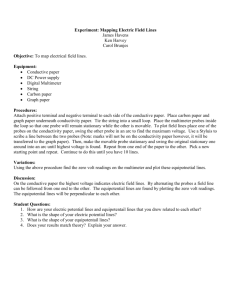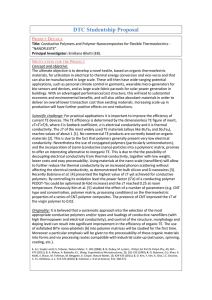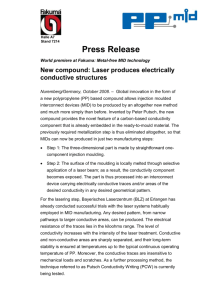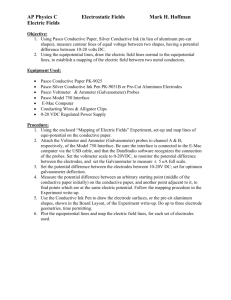A Selfhealing Conductive Ink
advertisement
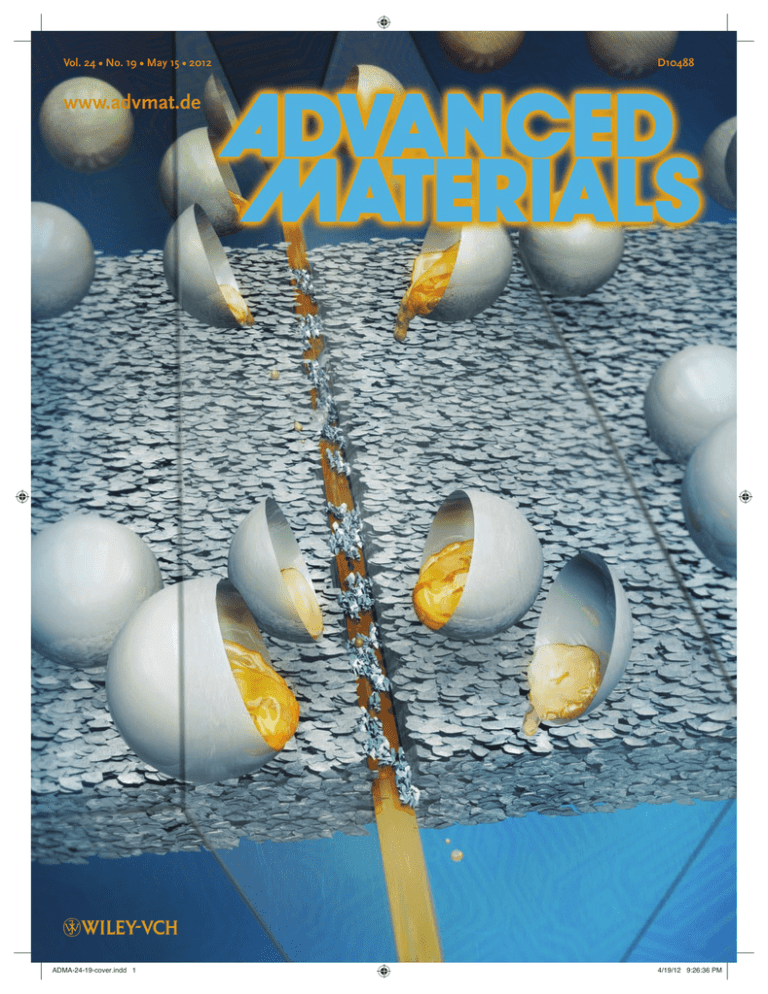
Vol. 24 • No. 19 • May 15 • 2012 D10488 www.advmat.de ADMA-24-19-cover.indd 1 4/19/12 9:26:36 PM www.advmat.de www.MaterialsViews.com COMMUNICATION A Self-healing Conductive Ink Susan A. Odom, Sarut Chayanupatkul, Benjamin J. Blaiszik, Ou Zhao, Aaron C. Jackson, Paul V. Braun, Nancy R. Sottos, Scott R. White,* and Jeffrey S. Moore* The mechanical durability of conductive materials affects the performance and lifetimes of devices ranging from electrical circuits to battery electrode materials. Mismatches in thermal expansion coefficient, Young’s modulus, and Poisson’s ratio between the conductive materials and packaging materials in integrated circuits lead to delaminations and fractures both within conductive pathways and at interconnects.[1,2] Fatigue causes microcracks that can lead to channeling, debonding, and failure.[3–5] The repeated lithiation and delithiation of battery electrode materials upon charging and discharging contribute to decreased capacitance due to a loss of interparticle connectivity and conductivity.[6–9] Numerous approaches have been used to design circuits and materials to prevent mechanical failure, but only a few have focused on restoring conductivity after mechanical damage.[10–15] Autonomic restoration of electrical conductivity may greatly extend the lifetime of electronic materials. The greatest opportunity for significant short-term impact may be in devices in which human intervention is difficult and/or costly. For example, fault-tolerant computer chips are of interest in space applications in which field-programmable gate arrays[16] are used to self-diagnose and reroute damaged circuits. Redundant circuitry and integrated sensing add complexity, weight, and cost to fault-tolerant designs. In battery materials, longevity is an important concern limiting applications. Improving battery longevity by repairing mechanical failures in electrode materials would require complete disassembly of the battery cell to achieve repair. We are interested in developing general concepts to restore conductivity in mechanically damaged electronic materials without external intervention or relying on back-up circuits. Dr. S. A. Odom, O. Zhao, Prof. J. S. Moore Department of Chemistry Beckman Institute for Advanced Science & Technology University of Illinois at Urbana-Champaign 405 N. Mathews Ave. Urbana, IL 61801, USA E-mail: jsmoore@illinois.edu S. Chayanupatkul, B. J. Blaiszik, A. C. Jackson, Prof. P. V. Braun, Prof. N. R. Sottos Department of Materials Science & Engineering Beckman Institute for Advanced Science & Technology University of Illinois at Urbana-Champaign 405 N. Mathews Ave. Urbana, IL 61801, USA Prof. S. R. White Department of Aerospace Engineering Beckman Institute for Advanced Science & Technology University of Illinois at Urbana-Champaign 405 N. Mathews Ave. Urbana, IL 61801, USA E-mail: swhite@illinois.edu DOI: 10.1002/adma.201200196 Adv. Mater. 2012, DOI: 10.1002/adma.201200196 Recent efforts towards the autonomic restoration of conductivity have focused on delivering conductive materials to the site of damage from core–shell microcapsules.[10–12] Release of conductive materials has been demonstrated using microcapsules containing a suspension of conductive carbon nanotubes,[10] solutions of precursors to a conductive charge transfer salt,[11] and liquid metal alloys.[12] Conductivity restoration was demonstrated by manual delivery of core solutions to simulated cracks[11] or autonomic delivery to a cracked circuit.[12] In this paper, we report a new approach for self-healing: instead of releasing conductive materials from microcapsules, we utilize the conductive particles from the conductive ink itself to heal damage through subsequent particle redistribution. Upon mechanical damage, solvent released from microcapsules locally dissolves the polymer binder of the conductive ink, allowing for particle redistribution and restoration of conductivity upon solvent evaporation (Figure 1a–c). Conductive inks are a mixture of conductive particles, polymer binders, and dispersing solvents, and they have been used in the metallization of microcircuits,[17] solar cells,[18] large area electronic structures,[19] and solder for microelectronics packages.[20] More recently, conductive inks have been used to print flexible silver microelectrodes,[21] circuits on curvilinear surfaces,[22] and conductive text, electronic art, and 3D antennas on paper.[23] With direct screen printing,[24] ink-jet printing,[25] dip-pen nanolithography,[26] e-jet printing,[27] and direct writing,[28] many traditional processing steps can be eliminated, including the use of photoresists and etching. Metallic particles and polymer binder are usually mixed with one or more solvents that dissolve the polymer binder. We envisioned a healing concept where the polymer binder remains soluble after circuit deposition and the conductive components could subsequently redistribute upon contact with appropriate solvents. Here we demonstrate that encapsulated solvent delivered to particle/ binder circuits autonomically restores conductivity to mechanically damaged conductive inks, and that circuits with lines spaced 200–500 μm apart do not short circuit during the restoration process. We first explored the response of mechanically damaged conductive inks to a variety of solvents. Inks consisted of silver particles in a acrylic binder, deposited as lines, on a glass substrate. Scratching these lines resulted in a complete loss of electrical conductivity. Subsequently, a drop of solvent was applied to the scratched region. After solvent evaporation, conductivity was restored for a subset of the solvents screened. Conductivity restoration occurrs with a variety of organic solvents that dissolve the polymer binder of the conductive ink including xylenes, chlorobenzene, ethyl phenylacetate, and hexyl acetate. Optical microscopy images of a line of conductive ink before and after solvent healing (Figure 2a and b) demonstrate the © 2012 WILEY-VCH Verlag GmbH & Co. KGaA, Weinheim wileyonlinelibrary.com 1 www.advmat.de COMMUNICATION www.MaterialsViews.com Figure 1. Representation of self-healing silver particle sample a) before damage, b) immediately after damage, showing solvent release from microcapsules, and c) after healing, where the majority of solvent has evaporated. d) 3D representation of sample used for scratch testing. e) Top and f) side geometries of samples with dimensions shown. (Samples are not not drawn to scale.) Figure 2. Characterization of conductive ink and microcapsules. Optical micrograph of scratched silver ink circuits on a glass slide a) before damage and b) after a drop of solvent was added to the scratch and was allowed to evaporate. c) SEM image of polyurea/polyurea– formaldehyde (PU/PUF) microcapsules containing hexyl acetate with average diameter of 192 μm. d) SEM image of silver particles from the commercially available conductive ink. 2 wileyonlinelibrary.com ability of solvent to enable reorganization of the conductive particles. In the healed line, a scar from the original scratch is visible, yet an intact conductive pathway was formed. To extend these screening tests to a fully autonomic healing system, we included coreshell microcapsules ( Figure 2c and Supporting Information (SI), Figure S1a) to supply solvent to the conductive ink (see conductive ink particles in Figure 2d). Our design consists of silver particle ink lines deposited onto a plastic substrate with solvent-filled microcapsules incorporated into a polyurethane layer deposited atop the silver ink line (Figure 1a). Failure of the circuit via mechanical damage simultaneously releases solvent from the microcapsules (Figure 1b). By the mechanism described in the screening tests, released solvent locally dissolves the polymer binder, allowing the immobilized silver particles to redistribute and form a connected pathway once the solvent evaporates (Figure 1c), thus restoring electrical conductivity. We previously reported the preparation of hexyl acetate microcapsules[29] and chose to use this solvent because of its lower toxicity and affinity to dissolve the polymeric binder. We used a procedure optimized for solvent encapsulation[30] to prepare the capsules for this application. After filtration and drying, we sieved the capsules to isolate those ranging from 180–250 μm in diameter. The polyurethane layer, which is deposited over the ink line, contained hexyl acetate microcapsules for self-healing specimens or, as a control, no microcapsules (see Figure 1d–f for substrate geometry). To measure conductivity during damage and in the initial minutes after damage, we connected the silver ink line to a Wheatstone bridge via lead wires. For testing over hours or days, we measured the resistance using an ohmmeter. We used scratch damage to approximate stress-induced cracking. To mechanically damage the samples, a razor blade was used to apply scratches to the circuits, causing all samples to fail electrically. Scanning electron microscopy (SEM) analysis (SI, Figure S3) shows that the scratch extends through the conductive ink and into the underlying plastic substrate. For concentrations of capsules in the polyurethane layer between 10 and 30 wt%, a decrease in sample resistance was observed within 1–10 min (Figure 3a and SI, Figure S4). None of the control samples without microcapsules regained conductivity. We tested the conductivity restoration when the voltage was not actively monitored, and we found that © 2012 WILEY-VCH Verlag GmbH & Co. KGaA, Weinheim Adv. Mater. 2012, DOI: 10.1002/adma.201200196 www.advmat.de www.MaterialsViews.com Adv. Mater. 2012, DOI: 10.1002/adma.201200196 COMMUNICATION Figure 3. Conductivity response for conductive ink samples. a) Normalized bridge voltage (Vnorm) vs. time for a healing sample containing 30 wt% microcapsules and a control sample with no microcapsules. Scratch applied at time t = 20 s. b) Resistance of circuits prior to damage, 5 min after damage, 1 h after damage, and 1 week after damage. c) Percent of healed samples vs. wt% of microcapsules incorporated into the polyurethane healing layer. (Healing is defined as having a normalized bridge voltage of 0.8 or higher.) conductivity was restored, whether or not a voltage source was applied during the healing process. Although samples containing microcapsules healed within one hour of the damage event, the process of conductivity restoration continued on a longer time scale. Therefore, we monitored the circuit resistance over several days, and the resistance remained constant after ca. one week. For a representative sample set (Figure 3b), the average resistance of 1.45 Ω after one week is similar to the original resistance of 0.95 Ω. We presume the continued repair process is due to continued solvent evaporation, leading to increased interparticle contact. In contrast, after one week, the control sample (no microcapsules) showed no evidence of conductivity restoration. We investigated the effect of microcapsule concentration in the polyurethane layer on the percentage of samples in which conductivity was restored. Initial testing described above was performed with 30 wt% hexyl acetate capsules, and resulted restoration in almost 90% of the samples, which we defined as recovery of over 80% of original bridge voltage during initial testing (within 10 min). At lower capsule concentrations, a decrease was observed in the percentage of samples in which a change in resistance occurred (Figure 3c), suggesting that within the tested range of capsule loadings, increased solvent delivery facilitates the healing process. Additionally, we monitored adjacent ink lines for short circuits. We prepared an additional sample type in which a series of parallel lines with 200–500 μm separation distance. Simultaneous scratch damage of these lines initiated loss of conductivity, and subsequent conductivity restoration of the primary conductive pathway. However, of the 50 samples tested we did not observe electrical conduction between neighboring lines. While this value is larger than those reported in recent printed conductive ink circuits, which have separation distances of 5–10 μm,[21] it is important that at our larger distances do not result in short circuiting. In conclusion, we showed that solvent-filled microcapsules autonomically restore conductivity to lines of a conductive silver ink after scratch damage. Optical microscopy revealed that the relatively large gaps (ca. 25 μm) in the conductive ink are bridged by the reorganized silver particles. We found that a higher concentration of microcapsules leads to greater percent of samples that undergo conductivity restoration. It may be possible to achieve greater success in sample healing by optimizing the capsule size and volume of solvent released to the damaged area, and also by varying solvents to change polymer binder solubility and/or solvent volatility. This result represents the first example of a self-healing circuit in which the circuit material itself is used to repair damage. In addition to potential applications in integrated circuits, a solvent-healing mechanism could conceivably restore such capacity losses in electrodes fabricated from a soluble binder. Our system does not require rerouting to back-up circuitry and does not cause short-circuiting upon healing. Our result provides a new concept for the realization of fault-tolerant circuits. Experimental Section Silver ink circuits were prepared using SPI Conductive silver paint, which was painted onto acrylic substrates. Acrylic substrates were cut from a clear © 2012 WILEY-VCH Verlag GmbH & Co. KGaA, Weinheim wileyonlinelibrary.com 3 www.advmat.de COMMUNICATION www.MaterialsViews.com cast acrylic sheet 0.15 cm thick, purchased from McMaster-Carr, catalog number 8560K175. Clear Flex 50, a two-part polyurethane elastomer, was purchased from Smooth On, Inc. Hexyl acetate, urea, resorcinol, and formalin were purchased from Aldrich Chemical Co. Ethylene-maleic anhydride copolymer (Zemac-400) powder with an average molecular weight of 400 kDa (Vertellus) was used as a 2.5 wt% aqueous solution. The commercial polyurethane prepolymer, Desmodur L75, was purchased from Bayer Material Science and was used as received. Microcapsule Preparation: Microcapsules were prepared with slight modifications using our previously published procedures.[29,30] Similarly, 100 mL of distilled water was placed in a 600 mL beaker, along with 25 mL of 2.5 wt% ethylene co-maleic anhydride as a surfactant. The beaker was placed in a temperature-controlled water bath equipped with a mechanical stirring blade (40 mm diameter), which was brought to 400 rpm. To the aqueous solution was added the solid wall-forming materials: urea (2.50 g), ammonium chloride (0.25 g), and resorcinol (0.25 g). Afterward, the pH was raised from 2.7 to 3.5 by addition of NaOH (aq). Desmodur L75 (4 g) in hexyl acetate (60 mL) was added to the stirring solution, creating an emulsion. After 10 min, 6.33 g of formalin solution was added, and the temperature was increased to 55 ºC. The reaction proceeded under continuous stirring for 4 h after which the reaction mixture was allowed to cool to room temperature. The microcapsules were filtered the next day using a Buchner funnel, washing with water, and were dried under air for 24 h before sieving. Microcapsule Analysis: After isolation via filteration, microcapsules were sieved to collect those with diameters ranging from 125–180 μm. Optical micrographs of dried capsules in mineral oil on glass slides were taken using a Leica DMR Optical Microscope. Images of dried capsules were obtained using SEM (FEI/Philips XL30 ESEM-FEG) after sputter coating with a gold-palladium source. Thermogravimetric analysis (TGA) was performed on a Mettler-Toledo TGA851e, calibrated by indium, aluminum, and zinc standards. A heating rate of 10 ºC min−1 was used, and experiments were performed under nitrogen atmosphere from 25–450 ºC. For each experiment, approximately 5 mg of sample was used. Wheatstone Bridge Circuit: The conductive metal in each specimen acts as one resistor in an unbalanced constant voltage Wheatstone Bridge circuit. The voltage source is a BK Precision DC Power Supply (model 1710). The voltage gauge and voltage source are monitored by LabVIEW DAQ. Scratch damage was applied using a Corrocutter with razor blades at forces ranging from 28–30 N. A new razor blade was used for each measurement to ensure consistency in the integrity of the blade for each sample. Circuit Fabrication: Each circuit was 3 mm wide and ranged from 20–50 μm in thickness, as measured by profilometry. Each test sample contained three circuits to allow for testing of multiple samples at at the same time. Using a polydimethylsiloxane (PDMS) mold, a 1 mm thick film of polyurethane elastomer containing 0, 10, 20, or 30 wt% microcapsules was deposited on top of the silver particle circuits. Wires were then attached to the circuits using copper pads and solder. Sample Imaging: To obtain cross-sectional images, a diamond saw was used to cut thin slices of the circuits; our cuts were made perpendicular to the direction in which the scratch was applied. The samples were analyzed by SEM with analysis in reflectance mode. Not only are the conductive ink and capsule-containing polyurethane damaged, but the scratch also extends into the supporting polymer substrate. Supporting Information Supporting Information is available from the Wiley Online Library or from the author. Received: January 13, 2012 Published online: 4 wileyonlinelibrary.com [1] Proceedings of EuroSIME, Paris (Eds: R. B. R. van Silfhout, Y. Li, W. D. van Driel, L. J. Ernst) Shaker Publishing BV, Maastricht 2001. [2] P. Viswanadham, P. Singh, Failure Modes and Mechanisms in Electronic Packages, Chapman & Hall, London 1998. [3] J. W. Hutchinson, Z. Suo, Adv. Appl. Mech. 1992, 29, 63. [4] P. Servati, A. Nathan, Appl. Phys. Lett. 2005, 86, 033504. [5] G. Crawford, Flexible Flat Panel Display Technology, John Wiley & Sons, Ltd., Chichester, UK 2005. [6] J. Vetter, P. Novák, M. R. Wagner, C. Velt, K.-C. Möller, J. O. Besenhard, M. Winter, M. Wohlfahrt-Mehrens, C. Vogler, A. Hammouche, J. Power Sources 2005, 147, 269. [7] H. Gabrisch, J. Wilcox, M. M. Doeff, Electrochem. Solid-State Lett. 2008, 11, A25. [8] J. Christensen, J. Newman, J. Electrochem. Soc. 2006, 153, A1019. [9] Y. Itou, Y. Ukyo, J. Power Sources 2005, 146, 39. [10] M. M. Caruso, S. R. Schelkopf, A. C. Jackson, A. M. Landry, P. V. Braun, J. S. Moore, J. Mater. Chem. 2009, 19, 6093. [11] S. A. Odom, M. M. Caruso, A.D. Finke, A. M. Prokup, J. A. Ritchey, J. H. Leonard, S. R. White, N. R. Sottos, J. S. Moore, Adv. Funct. Mater. 2010, 20, 1721. [12] B. J. Blaiszik, S. L. B. Kramer, M. E. Grady, D. A. McIlroy, J. S. Moore, N. R. Sottos, S. R. White, Adv. Mater. 2012, 24, 398. [13] K. A. Williams, A. J. Boydston, C. W. Bielawski, J. R. Soc. Interface 2007, 4, 359. [14] S. Gupta, Q. Zhang, T. Emrick, A. C. Balazs, T. P. Russell, Nat. Mater. 2006, 5, 229. [15] G. V. Kolmakov, R. Revanur, R. Tangirala, T. Emrick, T. P. Russell, A. J. Crosby, A. C. Balazs, ACS Nano 2010, 4, 1115. [16] A. Akoglu, A. Sreeramareddy, J. G. Josiah, Cluster Computing 2009, 12, 269. [17] K. F. Teng, R. W. Vest, IEEE Trans. Comp. Hybrids and Manuf. Tech. 1987, 10, 545. [18] R. K. F. Teng, A. A. Mostafa, A. Karim, IEEE Trans. Ind. Electron. 1990, 37, 419. [19] M. H. Cheong, S. Wagner, IEEE Electron Dev. Lett. 2000, 21, 384. [20] D. J. Hayes, W. R. Cox, M. E. Grove, J. Electron. Manuf. 1998, 8, 209. [21] B. Y. Ahn, E. B. Duoss, M. J. Motala, X. Guo, S.-I. Park, Y. Xiong, J. Yoon, R. Nuzzo, J. A. Rogers, J. A. Lewis, Science 2009, 323, 1590. [22] J. J. Adams, E. B. Duoss, T. F. Malkowski, M. J. Motala, B. Y. Ahn, R. G. Nuzzo, J. T. Bernhard, J. A. Lewis, Adv. Mater. 2011, 23, 1335. [23] A. Russo, B. Y. Ahn, J. J. Adams, E. B. Duoss, J. T. Bernhard, J. A. Lewis, Adv. Mater. 2011, 23, 3426. [24] M. Hosokawa, K. Nogi, M. Naito, T. Yokoyama, Nanoparticle Technology Handbook, Elsevier, Oxford 2007. [25] P. R. Shepherd, P. S. A. Evans, B. J. Ramsey, D. J. Harrison, Electronics Lett. 1997, 33, 483. [26] S.-C. Hung, O. A. Nafday, J. R. Haaheim, F. Ren, G. C. Chi, S. J. Pearton, J. Phys. Chem. C 2010, 114, 9672. [27] J.-U. Park, S. Lee, S. Unarunotia, Y. Sun, S. Dunham, T. Song, P. M. Ferreira, A. G. Alleyene, U. Paik, J. A. Rogers, Nano Lett. 2010, 10, 584. [28] B. Y. Ahn, D. J. Lorang, J. A. Lewis, Nanoscale 2011, 3, 2700. [29] M. M. Caruso, B. J. Blaiszik, S. R. White, N.R. Sottos, J. S. Moore, Adv. Funct. Mater. 2008, 18, 1898. [30] M. M. Caruso, B. J. Blaiszik, H. Jin, S. R. Schelkopf, D. S. Stradley, N. R. Sottos, S. R. White, J. S. Moore, ACS Appl. Mater. Interfaces 2010, 2, 1195. © 2012 WILEY-VCH Verlag GmbH & Co. KGaA, Weinheim Adv. Mater. 2012, DOI: 10.1002/adma.201200196
